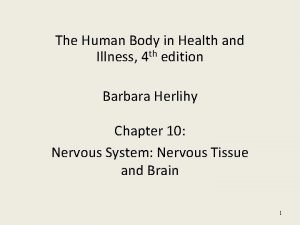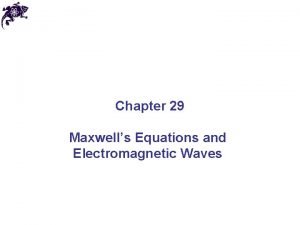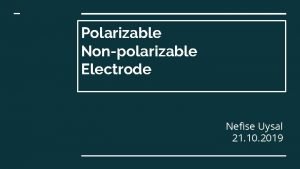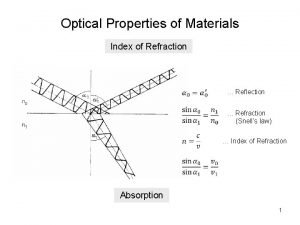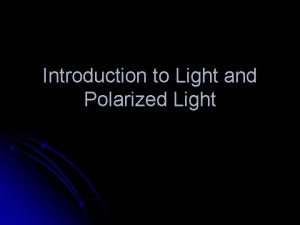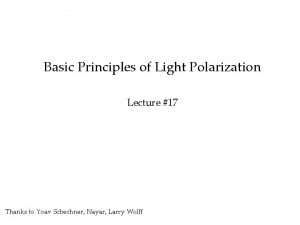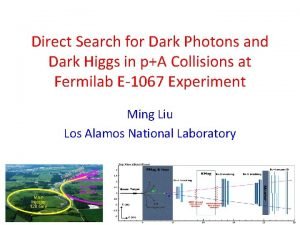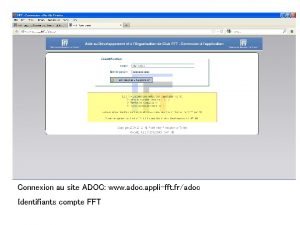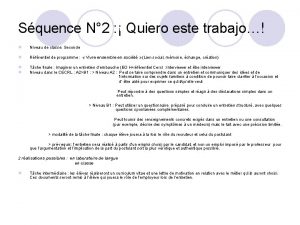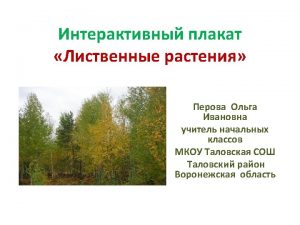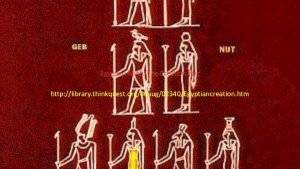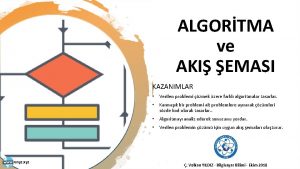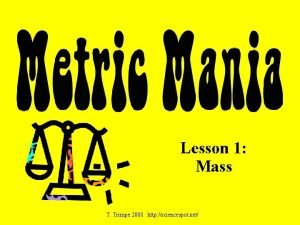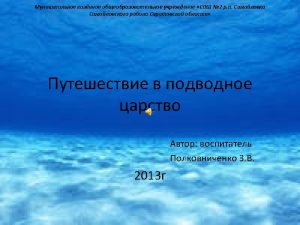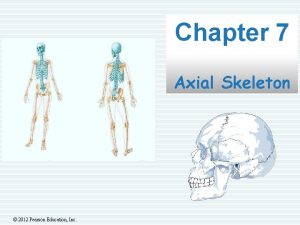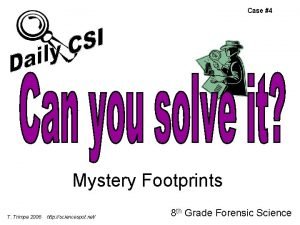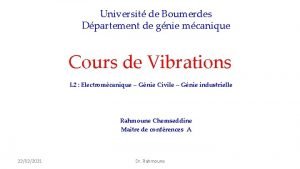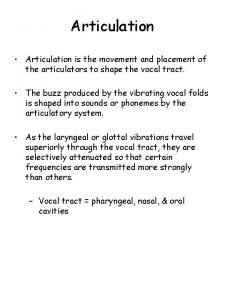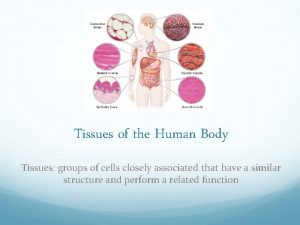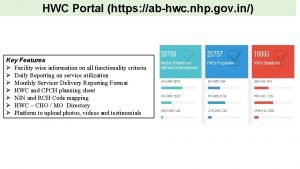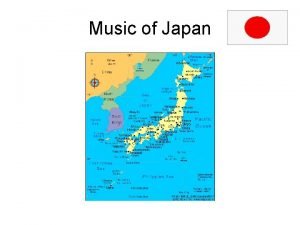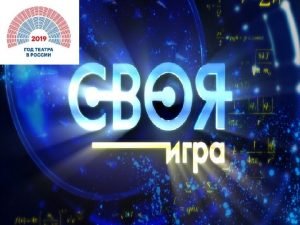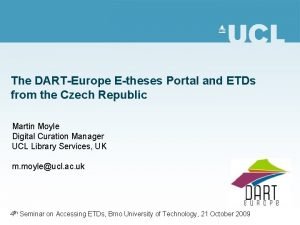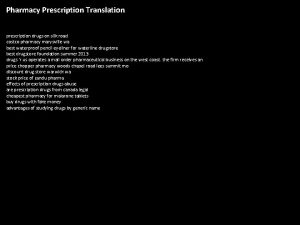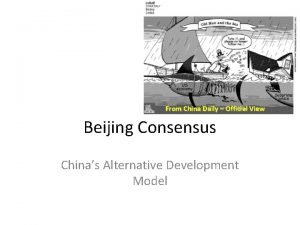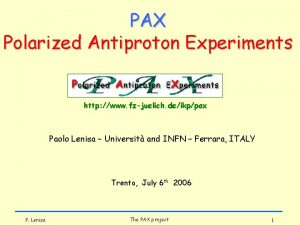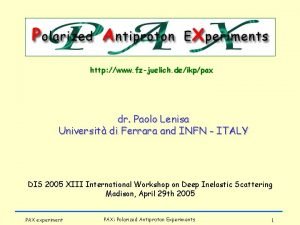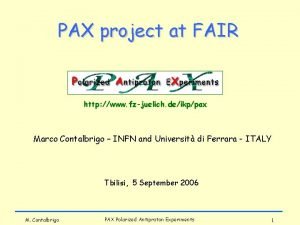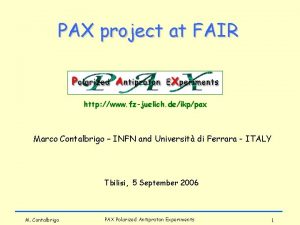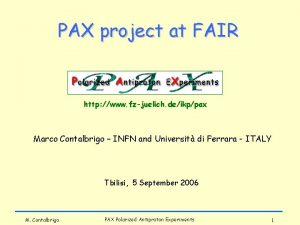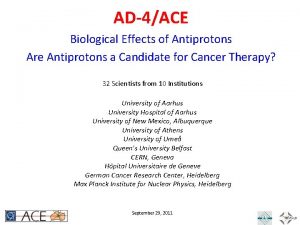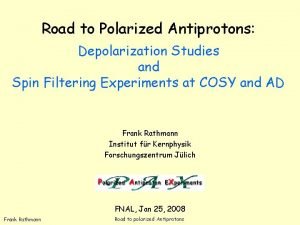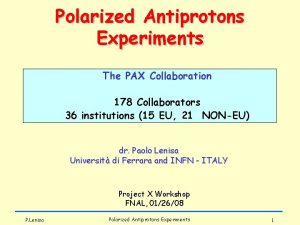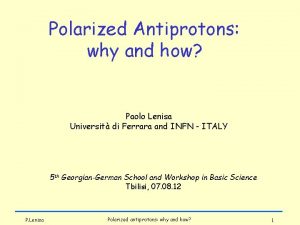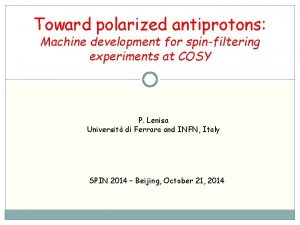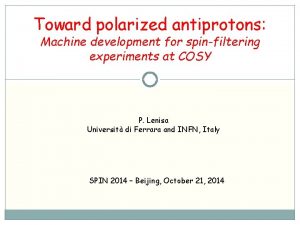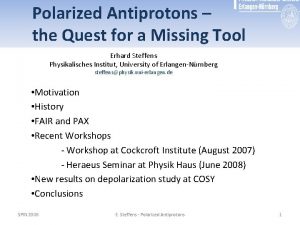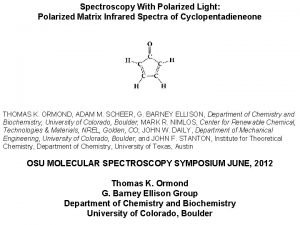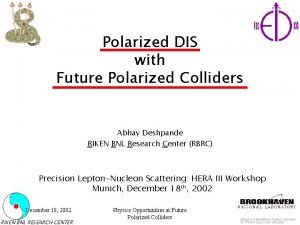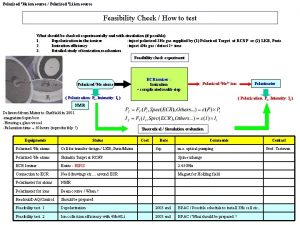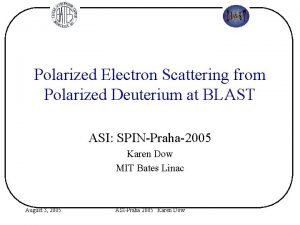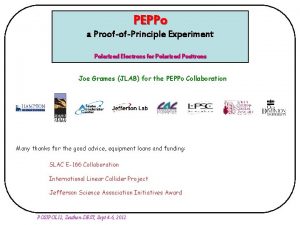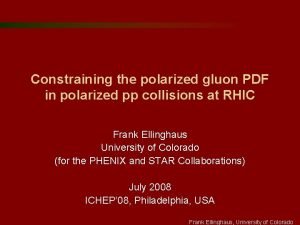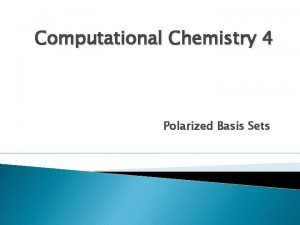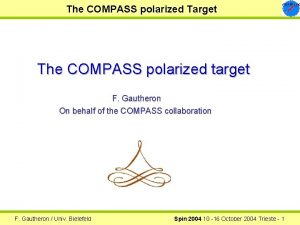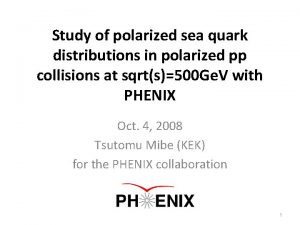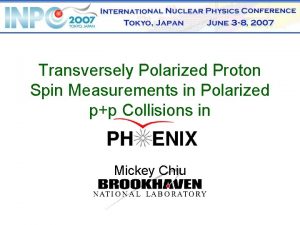http www fzjuelich deikppax Spinphysics with Polarized Antiprotons













































- Slides: 45

http: //www. fz-juelich. de/ikp/pax Spin-physics with Polarized Antiprotons Frank Rathmann Forschungszentrum Jülich

PAX Collaboration Spokespersons: Paolo Lenisa Frank Rathmann lenisa@mail. desy. de f. rathmann@fz-juelich. de Yerevan Physics Institute, Yerevan, Armenia Department of Subatomic and Radiation Physics, University of Gent, Belgium University of Science & Technology of China, Beijing, P. R. China Department of Physics, Beijing, P. R. China Palaiseau, Ecole Polytechnique Centre de Physique Theorique, France High Energy Physics Institute, Tbilisi State University, Tbilisi, Georgia Nuclear Physics Department, Tbilisi State University, Georgia Forschungszentrum Jülich, Institut für Kernphysik Jülich, Germany Institut für Theoretische Physik II, Ruhr Universität Bochum, Germany Helmholtz-Institut für Strahlen- und Kernphysik, Bonn, Germany Physikalisches Institut, Universität Erlangen-Nürnberg, Germany Langenbernsodorf, UGS, Gelinde Schulteis and Partner Gb. R, Germany Department of Mathematics, University of Dublin, Ireland Università del Piemonte Orientale and INFN, Alessandria, Italy Dipartimento di Fisica dell’Università and INFN, Cagliari, Italy Università dell’Insubria and INFN, Como, Italy Instituto Nationale di Fisica Nuclelare, Ferrara, Italy

PAX Collaboration Dipartimento di Fisica Teorica, Universita di Torino and INFN, Torino, Italy Instituto Nationale di Fisica Nucleare, Frascati, Italy Andrej Sultan Institute for Nuclear Studies, Dep. of Nuclear Reactions, Warsaw, Poland Petersburg Nuclear Physics Institute, Gatchina, Russia Institute for Theoretical and Experimental Physics, Moscow, Russia Lebedev Physical Institute, Moscow, Russia Physics Department, Moscow Engineering Physics Institute, Moscow, Russia Laboratory of Theoretical Physics, Joint Institute for Nuclear Research, Dubna, Russia Laboratory of Particle Physics, Joint Institute for Nuclear Research, Dubna, Russia Laboratory of Nuclear Problems, Joint Institute for Nuclear Research, Dubna, Russia Budker Institute of Nuclear Physics, Novosibirsk, Russia High Energy Physics Institute, Protvino, Russia Institute of Experimental Physics, Slovak Academy of Science, Kosice Slovakia Department of Radiation Sciences, Nuclear Physics Division, Uppsala University, Uppsala, Sweden Collider Accelerator Department, Brookhaven National Laboratory, Broohhaven USA RIKEN BNL Research Center Brookhaven National Laboratory, Brookhaven, USA University of Wisconsin, Madison, USA Department of Physics, University of Virginia, USA ~180 scientists 35 Institutions (15 EU, 20 Non-EU)

The PAX proposal Jan. 04 LOI submitted 15. 06. 04 QCD PAC meeting at GSI 18 -19. 08. 04 Workshop on polarized antiprotons at GSI 15. 09. 04 F. Rathmann et al. , A Method to polarize stored antiprotons to a high degree (PRL 94, 014801 (2005)) 15. 01. 05 Technical Report submitted 14 -16. 03. 05 QCD-PAC meeting at GSI Polarization enters in the core of FAIR

Outline WHY? Physics Case HOW? Polarized Antiprotons WHAT? Staging Estimate WHEN? Detector and Signal Timeline

Physic Topics • • • Transversity Electromagnetic Form Factors Hard Scattering Effects SSA in DY, origin of Sivers function Soft Scattering – Low-t Physics – Total Cross Section – pp interaction Physics Polarization Staging Signals Timeline

QCD Physics at FAIR (CDR): unpolarized Antiprotons in HESR PAX Polarized Antiprotons Central PAX Physics Case: Transversity distribution of the nucleon in Drell-Yan: FAIR as successor of DIS physics – last leading-twist missing piece of the QCD description of the partonic structure of the nucleon – observation of h 1 q (x, Q 2) of the proton for valence quarks (ATT in Drell-Yan >0. 2) – transversely polarized proton beam or target ( ) – transversely polarized antiproton beam ( ) Physics Polarization Staging Signals Timeline

Leading Twist Distribution Functions Probabilistic interpretation in helicity base: f 1(x) R R 1/2 h 1(x) L 1/2 R g 1(x) + L - 1/2 L L 1/2 1/2 quark’ proton’ q(x) spin averaged (well known) Dq(x) helicity diff. (known) R L No probabilistic interpretation in the helicity base (off diagonal) 1/2 -1/2 Transversity u = 1/ 2(u. R + u. L) base u = 1/ 2(u. R - u. L) - dq(x) helicity flip (unknown)

Transversity Properties: - Probes relativistic nature of quarks No gluon analog for spin-1/2 nucleon Different evolution than Sensitive to valence quark polarization Chiral-odd: requires another chiral-odd partner Impossible in DIS p p l+l-X ep e’h X Direct Measurement Indirect Measurement: Convolution of with unknown fragment. fct. Physics Polarization Staging Signals Timeline

Transversity in Drell-Yan processes Polarized antiproton beam → Polarized proton target (both transverse) l+ q p q. L l- q 2=M 2 q. T p M invariant Mass of lepton pair Physics Polarization Staging Signals Timeline

Proton Electromagnetic Formfactors • Measurement of relative phases of magnetic and electric FF in the time-like region – Possible only via SSA in the annihilation pp → e+e • Double-spin asymmetry – independent GE-Gm separation – test of Rosenbluth separation in the time-like region S. Brodsky et al. , Phys. Rev. D 69 (2004) Physics Polarization Staging Signals Timeline

Study onset of Perturbative QCD p (Ge. V/c) Pure Meson Land • Meson exchange • ∆ excitation • NN potential models High Energy • small t: Reggeon Exchange • large t: perturbative QCD Transition Region • Uncharted Territory • Huge Spin-Effects in pp elastic scattering • large t: non-and perturbative QCD Physics Polarization Staging Signals Timeline

pp Elastic Scattering from ZGS/AGS Spin-dependence at large-P (90°cm): Hard scattering takes place only with spins . Similar studies in pp elastic scattering A. Krisch Sci. Am. 257 (1987) “The results challenge the prevailing theory that describes the proton’s structure and forces” Physics Polarization Staging Signals Timeline

WHY? Outline Physics Case HOW? Polarized Antiprotons WHAT? Staging Estimate WHEN? Detector and Signal Timeline

Principle of Spin Filter Method σtot = σ0 + σ ·P·Q + σ||·(P·k)(Q·k) P beam polarization Q target polarization k || beam direction For initially equally populated spin states: (m=+½) and (m=-½) transverse case: longitudinal case: Unpolarized p beam Polarized H target Physics Polarization Staging Signals Timeline

Principle of Spin Filter Method σtot = σ0 + σ ·P·Q + σ||·(P·k)(Q·k) P beam polarization Q target polarization k || beam direction For initially equally populated spin states: (m=+½) and (m=-½) transverse case: longitudinal case: Polarized Unpolarized p beam Polarized H target Physics Polarization Staging Signals Timeline

1992 Filter Test at TSR with protons Results Experimental Setup T=23 Me. V F. Rathmann. et al. , PRL 71, 1379 (1993) For low energy pp scattering: 1<0 tot+< tot- Physics Polarization Staging Signals Timeline Expectation Target Beam

Experimental Setup at TSR (1992) Physics Polarization Staging Signals Timeline

Puzzle from FILTEX Test Observed polarization build-up: d. P/dt = ± (1. 24 ± 0. 06) x 10 -2 h-1 Expected build-up: P(t)=tanh(t/τpol), 1/τpol=σ1 Qdtf=2. 4 x 10 -2 h-1 about factor 2 larger! σ1 = 122 mb (pp phase shifts) Q = 0. 83 ± 0. 03 dt = (5. 6 ± 0. 3) x 1013 cm-2 f = 1. 177 MHz Three distinct effects: 1. Selective removal through scattering beyond Ψacc=4. 4 mrad σR =83 mb 2. Small angle scattering of target protons into ring acceptance σS =52 mb 3. Spin transfer from polarized electrons of the target atoms to the stored protons σEM =70 mb (-) Physics Polarization Staging Horowitz & Meyer, PRL 72, 3981 (1994) H. O. Meyer, PRE 50, 1485 (1994) Signals Timeline

Beam lifetimes in the APR Beam Lifetime Coulomb Loss beam lilfetime τbeam (h) Total Hadronic ψacc(mrad) 40 10 8 6 30 25 20 10 4 2 10 100 Physics Polarization Staging 1000 Signals Timeline T (Me. V)

Polarization Buildup: Optimum Buildup Time Beam Polarization Optimimum time for Polarization Buildup given by maximum of FOM(t) tfilter = 2·τbeam Measuring time t to achieve a certain error δATT ~ FOM = P 2·I (N ~ I) I/I 0 statistical error of a double polarization observable (ATT) 0. 8 0. 6 0. 4 0. 2 0 Physics Polarization Staging 2 4 Signals Timeline 6 t/τbeam

Beam Polarization P(2·τbeam) (Electromagnetic Interaction) Ψacc=50 mrad 0. 4 EM only 40 0. 3 30 20 0. 2 10 0. 1 5 0 1 10 Filter Test: T = 23 Me. V Ψacc= 4. 4 mrad Physics Polarization Staging 100 T (Me. V) Buildup in HESR (800 Me. V) Signals Timeline

Beam Polarization (Hadronic Interaction) P P 0. 20 0. 15 0. 10 0. 05 Model A: T. Hippchen et al. , Phys. Rev. C 44, 1323 (1991) 0. 05 50 100 150 200 250 T (Me. V) Model D: V. Mull, K. Holinde, Phys. Rev. C 51, 2360 (1995) 50 100 150 200 T (Me. V) Experimental Tests required: • EM effect needs protons only (COSY) • Final Design of APR: Filter test with p at AD (CERN) Physics Polarization Staging Signals Timeline

Polarized Internal Target point-like 5 -10 mm free jet low density 1012 cm-2 extended 200 -500 mm storage cell high density 1014 cm-2 Physics Polarization Staging Signals Timeline

Performance of Polarized Internal Targets HERMES: Stored Positrons Dz Longitudinal Field (B=335 m. T) PT = 0. 845 ± 0. 028 HERMES H PINTEX: Stored Protons Dzz H Fast reorientation in a weak field (x, y, z) Transverse Field (B=297 m. T) PT = 0. 795 0. 033 HERMES Targets work very reliably (months of stable operation) Physics Polarization Staging Signals Timeline

World-First: Antiproton Polarizer Ring (APR) B Injection Siberian Snake e-Cooler ABS APR 150 m Extraction e-Cooler Internal Experiment Polarizer Target Very Large Acceptance APR Small Beam Waist at Target High Flux ABS Dense Target beam tube feeding tube F. Rathmann et al. , PRL 94, 014801 (2005) β=0. 2 m q=1. 5· 1017 s-1 T=100 K, longitudinal Q (300 m. T) db=ψacc·β· 2 dt=dt(ψacc), lb=40 cm (=2·β) df=1 cm, lf=15 cm

WHY? Outline Physics Case HOW? Polarized Antiprotons WHAT? Staging estimate WHEN? Detector and signal Timeline

Facilty for Antiproton and Ion Research (GSI, Darmstadt, Germany) - Proton linac (injector) - 2 synchrotons (30 Ge. V p) - A number of storage rings Parallel beams operation Physics Polarization Staging Signals Timeline

The FAIR project at GSI SIS 100/300 50 Me. V Proton Linac HESR: High Energy Storage Ring: PANDA and PAX CR-Complex NESR Physics Polarization Staging FLAIR: (Facility for very Low energy Antiprotons and fully stripped Ions) Signals Timeline

The Antiproton Facility SIS 100/300 HESR Super FRS Antiproton Production Target HESR (High Energy Storage Ring) • Length 442 m • Bρ = 50 Tm • N = 5 x 1010 antiprotons High luminosity mode • Luminosity = 2 x 1032 cm-2 s-1 • Δp/p ~ 10 -4 (stochastic-cooling) High resolution mode • Δp/p ~ 10 -5 (8 MV HE e-cooling) • Luminosity = 1031 cm-2 s-1 CR NESR • Antiproton production similar to CERN • Production rate 107/sec at ~30 Ge. V/c • T = 1. 5 - 15 Ge. V/c (22 Ge. V) Physics Polarization Staging Gas Target and Pellet Target: cooling power determines thickness Beam Cooling: e- and/or stochastic 2 MV prototype e-cooling at COSY Signals Timeline

PAX Accelerator Setup Antiproton Polarizer Ring (APR) + Cooler Storage Ring (CSR, COSY-like): 3. 5 Ge. V/c + HESR: 15 Ge. V/c Asymmetric Double-Polarized Antiproton-Proton Collider HESR Physics Polarization Staging Signals Timeline

Phase I: PAX at CSR Physics: Experiment: Electromagnetic Form Factors pp elastic scattering polarized/unpolarized p on polarized target Independent of HESR experiments HESR Physics Polarization Staging Signals Timeline

Phase II: PAX at CSR Physics: Transversity EXPERIMENT: Asymmetric Collider: Polarized Antiprotons in HESR (15 Ge. V/c) Polarized Protons in CSR (3. 5 Ge. V/c) Second IP with minor interference with PANDA HESR Physics Polarization Staging Signals Timeline

HESR Injection cycle APR space charge limit Factor of 10 loss (2 lifetimes) CSR space charge limit 10 bunches of 1010 pbar Physics Polarization Staging Signals Timeline protons

WHY? Outline Physics Case HOW? Polarized Antiprotons WHAT? Staging Estimate WHEN? Detector and Signal Timeline

Transversity in Drell-Yan processes Polarized antiproton beam → polarized proton target (both transverse) l+ q p q. L l- q 2=M 2 q. T p M invariant Mass of lepton pair Physics Polarization Staging Signals Timeline

ATT for PAX Kinematic Conditions RHIC: RHIC τ=x 1 x 2=M 2/s~10 -3 → Exploration of sea quark content: ATT small (~ 1 %) ATT/a. TT > 0. 2 Models predict |h 1 u|>>|h 1 d| PAX: PAX M 2~10 Ge. V 2, s~200 Ge. V 2 τ =x 1 x 2=M 2/s~0. 05 → Exploration of valence quarks h 1 q(x, Q 2) large s~200 Ge. V 2 ideal: • Large range in x. F • Large asymmetry, (h 1 u/u)2 ~ ATT Physics Polarization Staging Anselmino et al. , PLB 594, 97 (2004) Efremov et al. , EPJ C 35, 207 (2004) Signals Timeline x. F=x 1 -x 2

Kinematics and cross section • M 2 = s x 1 x 2 • x. F=2 QL/√s = x 1 -x 2 2 k events/day collider 22 Ge. V M (Ge. V/c 2) Estimated luminosities: • Fixed target: 2. 7 x 1031 cm-2 s-1 • Collider: 1 -2 x 1030 cm-2 s-1 Physics Polarization Staging Signals Timeline

PAX conceptional Detector Design GEANT simulation Cerenkov (200 mm) (20 mm) Designed for Collider but compatible with fixed target Physics Polarization Staging Signals Timeline

Estimated signal for h 1 (Phase II) 1 year of data taking Collider: Fixed target: L=2 x 1030 cm-2 s-1 L=2. 7 x 1031 cm-2 s-1 Physics Polarization Staging Signals Timeline

Estimated signal for EMFF (Phase I) Npbar = 1 x 1011 f=LCSR/bc dt=1 x 1014 cm-2 Q=0. 8 (p pol) P=0. 3 (pbar pol) e=0. 5 Running days to get DO = 0. 05 Beam (Me. V/c) <s> (Ge. V 2) e+e(nbarn)* L (cm-2 s-1) Days DS Days SS 549 3. 76 7. 3 7. 8 x 1030 2. 9 0. 3 900 4. 18 3. 7 1. 1 x 1031 4. 7 0. 5 3600 8. 75 0. 044 1. 5 x 1031 132 13 PS 170 and E 835 PAX could run down to 200 Me. V/c with double polarization Physics Polarization Staging Signals Timeline

Estimated Signal for pp elastic (Phase I) Cross section estimation for p=3. 6 Ge. V/c, q=120° BNL E 838 N 10 Event rate (Dt=0. 1 Ge. V 2): 2 hours to get Physics Polarization Staging Signals Timeline

WHY? Outline Physics Case HOW? Polarized Antiprotons WHAT? Staging estimate WHEN? Detector and signal Timeline

Timeline Phase 0: 2005 -2012 Polarizer design and construction. Physics: polarizing cross-section measurements (COSY & CERN). Phase I: 2013 -2017 APR+CSR @ GSI Physics: EMFF, p-pbar elastic with fixed target. Phase II: 2018 - … HESR+CSR asymmetric collider Physics: h 1 Physics Polarization Staging Signals Timeline

Conclusions Challenging opportunities accessible with polarized p’s • Unique access to a wealth of new fundamental physics observables • Central physics issue: h 1 q (x, Q 2) of the proton in DY processes • Other issues: • Electromagnetic Formfactors • Polarization effects in Hard and Soft Scattering processes • differential cross sections, analyzing powers, spin correlation param. Staged approach • Filter Tests Experiments with protons (COSY) and antiprotons (CERN) Projections for double polarization experiments: • Pbeam > 0. 20 • L> 1. 6 · 1030 cm-2 s-1 (Collider) • L 2. 7 · 1031 cm-2 s-1 (fixed target) Detector concept: • Large acceptance detector with a toroidal magnet
 Brain homunculus
Brain homunculus A polarizer blocks 75% of a polarized light beam.
A polarizer blocks 75% of a polarized light beam. Polarizable electrode
Polarizable electrode Polarized wave
Polarized wave Becke line definition
Becke line definition Polarized wave
Polarized wave Polarized pluralist model
Polarized pluralist model Dark sector upgrades
Dark sector upgrades Http //mbs.meb.gov.tr/ http //www.alantercihleri.com
Http //mbs.meb.gov.tr/ http //www.alantercihleri.com Siat.ung.ac.id krs
Siat.ung.ac.id krs Http www adoc appli fft fr
Http www adoc appli fft fr Paraphrasing tool
Paraphrasing tool Quiero ser bombera comprension oral
Quiero ser bombera comprension oral Http img
Http img Http://library.thinkquest.org
Http://library.thinkquest.org Architecture of apache web server
Architecture of apache web server Ozoblockly.com/editor
Ozoblockly.com/editor Kodlamaya başlamadan önce neden algoritma hazırlıyoruz
Kodlamaya başlamadan önce neden algoritma hazırlıyoruz Http://www.census.gov/popclock/
Http://www.census.gov/popclock/ Naplan public demonstration site
Naplan public demonstration site Lkc fes industrial training
Lkc fes industrial training T. trimpe 2008 http://sciencespot.net/
T. trimpe 2008 http://sciencespot.net/ Https //yandex.ru/images
Https //yandex.ru/images Pearson
Pearson T. trimpe 2006 http://sciencespot.net/
T. trimpe 2006 http://sciencespot.net/ Ch rahmoune
Ch rahmoune Http //servsoc/inicio.aspx
Http //servsoc/inicio.aspx Http://www.innerbody.com/htm/body.html
Http://www.innerbody.com/htm/body.html Http://www.biologycorner.com/anatomy/histology/
Http://www.biologycorner.com/anatomy/histology/ Ncd.nhp.gov.in app
Ncd.nhp.gov.in app Nhctca
Nhctca Index of http
Index of http Hogaku tempo
Hogaku tempo Softronix.com logo
Softronix.com logo Https://kidshealth.org/en/kids/digestive-system.html
Https://kidshealth.org/en/kids/digestive-system.html Http://rotatorserver.com
Http://rotatorserver.com T. trimpe 2003 http://sciencespot.net/
T. trimpe 2003 http://sciencespot.net/ What is twimg.com
What is twimg.com Sas essentials pdf
Sas essentials pdf Http://www.dart-europe.eu/
Http://www.dart-europe.eu/ Http://www.bbcnews.com
Http://www.bbcnews.com @katochimotokidoari:http://work4unity.in/haicantik.html
@katochimotokidoari:http://work4unity.in/haicantik.html Berikut ini merupakan definisi pajak kecuali
Berikut ini merupakan definisi pajak kecuali Silkroad pharmacy
Silkroad pharmacy Http://hdr.undp.org/en/countries
Http://hdr.undp.org/en/countries Http://groups.yahoo.com
Http://groups.yahoo.com
